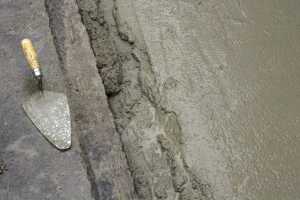Given just how ubiquitous concrete has become when it comes to construction, it’s unsurprising that so many urban landscapes are uniformly grey. But why is concrete grey? Given the broad variety of natural materials and minerals that we have at our disposal, the construction material that we know so well today could quite easily have been a different colour.

Why is concrete grey?
Of course, if you want to get really abstract, then it’s best to start with why materials appear to be a certain colour at all. This is to do with the way they absorb and reflect light. If a material completely absorbs light, it will appear black to us; if a material completely reflects the light, it will appear white. For a material to appear grey, then, or any other colour in between for that matter, it will do some combination of reflection and absorption when it interacts with light.
So, we’ve covered the more obscure part, let’s get a bit more specific. What is it about concrete specifically that’s causing this greyness? Which one of its constituent bits can be said to have that property? If you’ve been reading our blog, you’ll know that concrete is a mixture of cement, water and aggregates. Let’s take a look at cement.
Cement consists of four distinct mineral phases: two calcium silicates, a calcium aluminate, and a mixed crystal known as calcium aluminate ferrite (C4AF). While the first two mineral phases appear naturally white in colour, C4AF appears to be brownish, thanks to its iron content. While, in theory, you’d think that cement, and by extension concrete, would be brown, C4AF is often contaminated with magnesium, which lends the final product a greyish-green colour.
Can I change the colour of my concrete floor?
The short answer: yes. Creating the right colour for your concrete floor involves finding the perfect balance of water content, aggregate size and, of course, the right kind of cement and pigmentation. While we would always advise that a grey concrete floor is stylish and timeless, if you have decided that you want to change the colour of your concrete floor, we wouldn’t suggest tackling this by yourself.
Here at EasyMix, we’ve been mastering the art of concrete recolouring for decades, so if you’re looking for fast and accurate service, we would be more than happy to discuss your options with you.
How can I avoid the discolouration of my concrete?
The discoloration of concrete flooring is usually associated with the wrinkling of the polyethylene cover and is often referred to as the “greenhouse effect”. Moisture evaporates and condenses beneath plastic sheeting, which can ultimately result in discolouration. If you’re looking to avoid discolouration, it’s important to properly maintain your concrete floor (something we’ll be covering in a different article) It’s also worth noting that the use and relative percentage of admixtures can also affect the color. For example, mineral admixtures such as silica fume can darken concrete over time.
EasyMix are proud to provide customers throughout Hertfordshire, Bedfordshire, Northamptonshire, Buckinghamshire, North London and the surrounding areas with quality concrete that has been produced to exceptionally high standards. Whether you’re undertaking a commercial or domestic project, EasyMix will have you covered. For more information about how we can help you, get in touch with us today.
